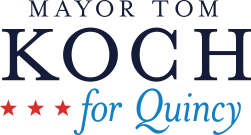On Education
 Mayor Koch has made an unprecedented investment in the Quincy Public Schools since taking office, with classroom spending increased by more than 47 percent.
Mayor Koch has made an unprecedented investment in the Quincy Public Schools since taking office, with classroom spending increased by more than 47 percent.
- 93.6 percent high school graduation rate, the highest for a City our size and substantially higher than the state average.
- 90 percent of graduates with a documented plan to attend college, enter the military or apprentice in a trade.
- Boston Magazine ranks the City’s two high schools better than any City in Massachusetts except Newton.
- Chosen by state to be studied as a model program for similar districts because of success rates.
- Substantive increases in teachers and staff to keep classroom size low and to expand programs.
- Average Elementary School Class Size: 19 students.
- 88 percent of Middle School classrooms under 24 students.
- 80 percent of High School classes under 25 students.
- MCAS scores the best of any City our size, and behind only Newton and Brookline among the 15 largest districts in the state.
The commitment to the classroom is matched our exceeded by a historic renewal of the City’s school facilities. Mayor Koch has leveraged working relationships with state leaders to secure more than $140 million in grant funding, totaling more than 70 percent of construction costs for major project, such as:
- A new Quincy High School, a new Central Middle School, a new South-West Middle School, and a new Squantum Elementary in the pipeline.
- A first-of-its Special Education Center to keep more Quincy students in town.
- Renovations at schools across the District.
Finances and Taxes
The City maintains its strongest, most stable financial standing in recent history following a series of reforms enacted by Mayor Koch amid the Great Recession. By creating savings, budgeting conservatively, and fixing long-standing deficiencies, the City now holds the second-highest bond rating from Wall Street possible for any community.
- Average single-family home tax bills lower than state average – even though values are growing faster than the state average.
- More than $100 million in direct taxpayers savings through innovative pension payment plan.
- Debt burden between 6 and 7 percent of total budget despite the amount of work being performed. State Average is 8 percent.
- No Proposition 2.5 overrides – meaning the City has capacity for major projects unlike other cities and towns.
- Excess Levy Capacity, which are property taxes the City is allowed to collect under state law but doesn’t, is the fifth-highest of any community in Massachusetts at nearly $50 million.
- By comparison, the City of Boston holds less than $100 (Yes, $100) in excess levy capacity.
Parks and Open Spaces
As both Mayor and Park Director, the City has never had a more passionate steward of its parks and open spaces than Tom Koch. The City has undergone a renaissance of its park system through those years, much of it without costing a dime to local taxpayers thanks to a hotel and motel room tax paid for by visitors to the City.
- A fully restored Pageant Field with a new softball diamond, gathering space, walking trails and scenic vistas as well improvements to Merrymount Park Parkway.
- New open space in the downtown honoring the City’s remarkable service to the country and honoring 18 military generals from Quincy.
- The City’s first dog park.
- Protected open space and a new passive park at the former Beachcomber.
- The City’s first regulation track and field facility.
- The first state-of-the-art athletic facility for North Quincy High School at Creedon Field.
- The reconstruction of playing fields citywide, including Cavanagh Field and Atlantic Middle School.
- New soccer fields at Cleverly Court.
- Millions of dollars from the hotel tax for upgrades at parks citywide – including restored tennis and basketball courts, playing fields, and passive areas.
- The creation of dozens of acres of new open space and walking trails at Broad Meadows and Faxon Park.
- A once-in-a-generation investment in Kincaide Park, creating new playing fields, a walking path, and a splash pad.
- The protection of open space next door to the Adams National Historic Park.
- A sweeping reconstruction program at more than 20 playgrounds across the City, all financed through the Community Preservation Act.
- The completion of the Adams Walk at Upper Merrymount Park.
- A permanent World War I Memorial in a formerly blighted property at the corner of Furnace Brook Parkway and Hancock Street.
- The restoration of the green space at the Adams Academy.
- The world-class park in the heart of downtown in the Hancock-Adams Common – all financed through state grants and the hotel room tax.
- Renovations at Veterans Memorial Stadium paid for by a private partnership with a professional sports group.
Infrastructure and Transportation
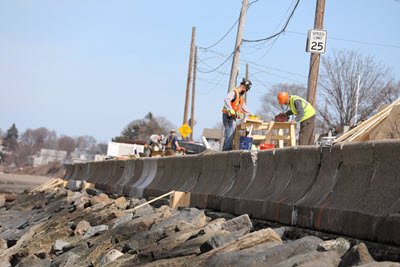 Mayor Koch took unprecedented steps to restore the City’s aging infrastructure, including roads, water and sewer lines, drainage systems, flood protection systems, traffic control equipment and public facilities. Much of the work has been matched by state and federal grant funding through the Mayor’s work with his fellow leaders
Mayor Koch took unprecedented steps to restore the City’s aging infrastructure, including roads, water and sewer lines, drainage systems, flood protection systems, traffic control equipment and public facilities. Much of the work has been matched by state and federal grant funding through the Mayor’s work with his fellow leaders
- More than 60 miles of reconstructed roads in just the last several years.
- Thousands of feet of new water and sewer lines.
- New, higher seawalls and improved drainage through Merrymount, Adams Shore and Post Island, with design underway to continue work through Houghs Neck.
- Millions in dollars, leveraged with federal funding, in West Quincy flood mitigation projects, including a major project to expand capacity of the Furnace Brook.
- The new Walter Hannon Parkway and Generals Bridge, providing the first East-West connection to Downtown.
- A reimagined and rebuilt traffic pattern in downtown, eliminating the dangerous four lanes of traffic between City Hall and the Church of the Presidents in favor of a park and pedestrian accessibility.
- An innovative traffic signalization system at more than 10 of the most difficult intersections in the City.
- Bicycle lanes installed on a number of a major arteries, with more to come.
- Working with state partners, a rebuilt Neponset River Bridge, a new Fore River Bridge, and repairs and reconstruction of bridges in North Quincy and West Quincy, among others.
- A state-of-the-art water meter system that has saved taxpayers millions of dollars by detecting leaks immediately.
- An expansive program to detect leaking sewer lines, dramatically reducing pollution.
- A conversion to LED streetlights after taking ownership of more than 6,000 lights from National Grid.
- A systematic program to improve drainage in neighborhoods across the City.
Public Safety
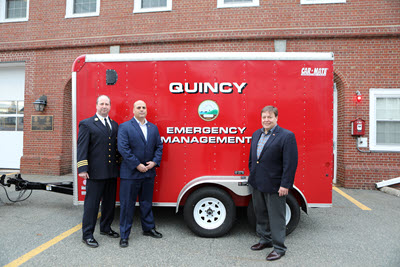 Together with Education, there is no more important function of government than protecting the lives and property of its citizens. Mayor Koch understands this, and it’s why he committed unprecedented resources to our Police and Fire Departments. It’s also why he’s earned the endorsement of our firefighters in every election.
Together with Education, there is no more important function of government than protecting the lives and property of its citizens. Mayor Koch understands this, and it’s why he committed unprecedented resources to our Police and Fire Departments. It’s also why he’s earned the endorsement of our firefighters in every election.
- Highest staffing levels in both the Police and Fire Departments since the 1980s.
- Manpower increases lead to a fourth Ladder Company in the Fire Department for the first time since 1989.
- Crime rates lower than any City our size.
- Important Fire Department Rescue One truck in service full-time for the first time.
- Reformed ambulance contract, leading to response times that are among the fastest anywhere in the state.
Our Seniors
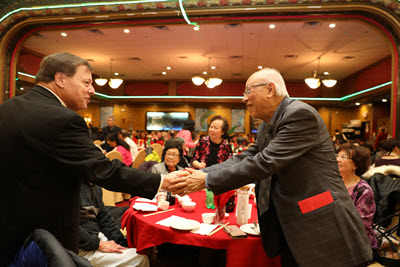 Mayor Koch’s first position with the City was as Director of the Council on Aging, and he’s continued a commitment to our seniors through his more than 30 years of experience with the City.
Mayor Koch’s first position with the City was as Director of the Council on Aging, and he’s continued a commitment to our seniors through his more than 30 years of experience with the City.
- Transformed a under-used former school building into The Kennedy Center For Seniors, the City’s first-ever senior center.
- The Kennedy Center served 10,000 of our residents last year.
- The first ever social worker added to the Kennedy Center to assist seniors with the myriad challenges they face.
- Transportation services run through the Kennedy Center expanded.
- A new park and passive open space now being designed as a complement to the Kennedy Center.
- An increase in the income limit for a property tax deferral program to the maximum allowed by law.
Economic Development
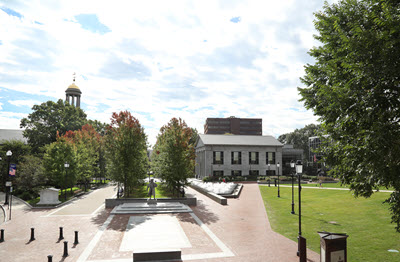 For 40 years, Quincy Center was in a state of decline following the exodus of businesses caused brought on by the advent of the shopping mall, specifically the South Shore Plaza. Mayor Koch took ownership of the downtown’s future immediately upon taking office. The progress to date has been nothing short of extraordinary, as a thriving neighborhood for people to live, work and play has taken shape over the last several years. As a result, the City is undergoing its most sustained period of growth in a generation.
For 40 years, Quincy Center was in a state of decline following the exodus of businesses caused brought on by the advent of the shopping mall, specifically the South Shore Plaza. Mayor Koch took ownership of the downtown’s future immediately upon taking office. The progress to date has been nothing short of extraordinary, as a thriving neighborhood for people to live, work and play has taken shape over the last several years. As a result, the City is undergoing its most sustained period of growth in a generation.
- More than $200 million in public infrastructure either completed or planned, and all of it financed by either state and federal grants or through the new tax revenue of the downtown. No residential property taxes are used for downtown redevelopment efforts.
- Hundreds of millions in private investment and hundreds of units of new housing units either occupied or under construction – for the 1st time making downtown a real neighborhood with the ability to support local businesses.
- More than a dozen restaurants opened in just the last few years to support the neighborhood.
- New commercial building on Washington Street and major tenants such as Beth-Isreal Deaconess and South Shore Hospital occupying space in a number of existing buildings for the 1st time in many years.
- Major expansion of space and number of employees at Stop and Shop Headquarters.
- New state-of-the-art parking garage, civic space and gallery in heart of downtown at Kilroy Square.
- The Hancock-Adams Common creating a first-of-its kind downtown civic space hosting community events year-round.
- Development projects citywide targeting transportation hubs, such as the North Quincy MBTA station, Wollaston Center, Crown Colony Office Park, among others.
- A master plan for the future of Wollaston Center following the renovation of the MBTA station now underway.
- Additional housing units support affordability, and do not impact schools or most other City services.
- No development allowed in the City’s single-family home neighborhoods.
Leadership
 It is the times of difficulty and crisis that define a leader, and Mayor Koch has more than met that definition by shepherding our community through emergencies ranging such as historic flooding to challenges like tackling head-on the substance abuse epidemic afflicting communities across the country
It is the times of difficulty and crisis that define a leader, and Mayor Koch has more than met that definition by shepherding our community through emergencies ranging such as historic flooding to challenges like tackling head-on the substance abuse epidemic afflicting communities across the country
- Navigated the City through the COVID-19 pandemic in a way that drew statewide attention by protecting public health while at the same time ensuring the City’s economy didn’t crash.
- Millions of dollars in federal funds awarded to nonprofits to protect the most vulnerable members of our community.
- Millions more in housing assistance for hospitality workers put out of work.
- And millions more in grants for small businesses to recover from the pandemic.
- Created an emergency housing fund for our residents impacted by the March 2018 coastal storm by using fees paid for by developers of major project.
- Created a similar home repair program using the same funding source — No other community in Massachusetts created similar programs.
- Major emergency repairs to coastal infrastructure were completed within a few months of the damage, again using millions of dollars in fees paid for by development projects.
- Activated resources from across the Northeast to assist the City during the record-breaking 2015 snow season, creating safe and functional roadways before many surrounding communities.
Substance Abuse Crisis
- Directed the Quincy Police Department to become the first Department in the nation to have its officers carry anti-overdose medication.
- Created a community-based task force used as model across the state.
- Dramatically expanded educational programs and launched major after-school initiative for our young people.
- One of the few communities in Massachusetts to use local resources to open and sustain an addiction recovery center.
- Efforts earn recognition from the White House Office of National Drug Control Policy.
